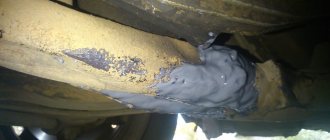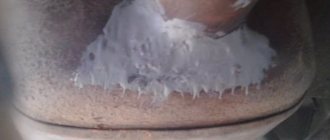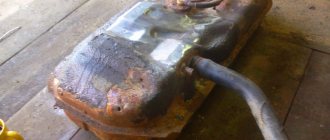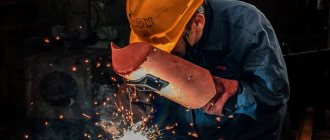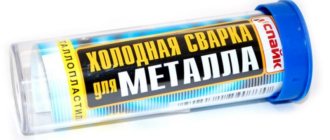Mastix cold welding can be used to join various parts and structural elements without melting. The joining process will be represented in the form of gluing. New interatomic bonds are not formed, plastic deformation does not occur, which happens during traditional welding, so we need to talk about glue, and not welding in its usual sense.
Technical characteristics of the glue
Mastix cold welding composition is multi-component. It includes the following components:
- Epoxy polymer (adhesive base).
- Plasticizers (used to increase the resistance of the epoxy polymer to mechanical loads, shocks, and vibrations).
- Fillers (mineral, metal). Thanks to them, the thermal conductivity of the glue increases and the strength characteristics are improved, which makes the connection resistant to temperature changes.
- Polyamine or amine hardener (necessary to stimulate the hardening of the mixture - hardening of a thin layer of Mastix cold weld occurs within a few minutes).
The percentage of components will depend on the type of Mastix cold weld. The manufacturer offers a wide selection of products designed to solve various technical problems.
The adhesive mass is presented in the form of a material resembling plasticine. It has a rod shape and consists of 2 layers separated by packaging (mix the layers before use). Products are produced in soft packaging. It is recommended to store at a temperature of no more than +30o C. Important characteristics include:
- Minimum operating temperature: -60° C.
- Maximum operating temperature: +200° C (or more depending on the type of glue).
- Beginning of the hardening process: 7 minutes after application.
- Weight: 55 g.
- Recommended storage temperature: no more than +30° C.
Composite composition
The basis of Mastix adhesive mixture is epoxy polymer. To increase resistance to vibration and shock loads, plasticizers are added to the resin.
Metallic and mineral fillers were also added to the mixture. They increase thermal conductivity, strength of the connection, and make it resistant to temperature changes.
To stimulate the hardening process of the composite, a hardener of diamine or polyamine origin is added to it. The paste-like composite, applied in a thin layer, begins to harden within 7 minutes.
It will take longer for the entire thickness of the cold weld to fully harden. After complete polymerization of the glue, the repaired parts are ready for use.
The Mastix line of adhesives is represented by several modifications. Among them there are compositions for universal and specific purposes. Some types of cold welding are designed specifically for gas tanks, others are adapted for radiators, and others are for aluminum products.
In each specialized cold welding composition, strictly defined proportions of the initial components inherent in this modification are observed. Easy to use universal glue, suitable for all occasions.
Product area of use
The scope of application of Mastix cold welding will directly depend on the type of adhesive chosen. Therefore, the products are ideal for use in the following areas:
- Bonding of metal products, structural elements, parts.
- Durable connection of metal and non-metal products.
- Bonding of metals that during operation heat up to extreme temperatures (more than 200° C).
- Repair of plumbing products, gluing tiles, porcelain, marble, etc.
- Bonding of steel products.
- Bonding of aluminum products.
Application area
Mastix brand cold welding can handle any repair. The composition is used in enterprises, auto repair shops, and everyday life. Universal mixtures are used for gluing:
- metals: castings, rolled products from non-ferrous and steel alloys;
- wood, the plastic mass fills cracks well; with the help of Mastix, the strength of rafter structures and furniture frames is restored;
- glass, the composition glues refractory and organic glass products;
- ceramics, earthenware, porcelain, you can restore tiles, plumbing fixtures, and remove chips on insulators.
The area of use of the glue is not limited.
Advantages and disadvantages
Mastix cold welding is one of the most popular in its category on the Russian market.
This is due to the presence of the following positive characteristics:
- Versatility of use with metal and non-metal parts and elements.
- High-quality gluing of parts (better than many other types of similar adhesives).
- The ability to purchase a specific type of Mastix cold welding to perform a specific job (for example, joining plastic and metal products, repairing automotive parts, plumbing equipment, etc.).
- Easy to use and prepare - no special skills or experience are required to work with the mixture.
- Low cost (when compared with foreign analogues and products of other well-known domestic companies).
- Sophisticated delivery (sold as a two-component rod).
- Possibility of operating the finished connection at extreme sub-zero and plus temperatures.
The disadvantage of cold welding Mastix is that the drying time of the mixture is about 6-7 minutes. This is more than competing products. When carrying out urgent work, such time costs can be critical. Although this is still controversial and subjective.
Also, when mixing two components, you need to be extremely careful so that lumps do not form. They form frequently, so this fact can also be considered a disadvantage.
Types of cold welding Mastix
The Russian manufacturer Mastix offers different types of cold welding, which are produced under the brand of the same name:
- "Gas Tank Sealant" It is used for repairing gas tanks of trucks, agricultural machines, and special equipment. Tanks can be plastic or metal. Work can be carried out on oiled and water-filled surfaces.
- "Radiator sealant." A complete analogue of the previous mixture, but is used only for repairing radiators.
- "Glue for aluminum." Officially, it should only be used for bonding aluminum parts and structural elements. In practice, it is actively and successfully used for joining wooden, plastic, ceramic, and metal products in various combinations.
- "Glue for batteries and pipes." The mixture can be used to work with cold and hot pipelines, sewer systems, and batteries. Suitable for use in industrial and domestic areas.
- "Glue for bronze." Used to connect bronze products, as well as parts made of other types of non-ferrous and ferrous metals.
- "Glue on oily surfaces." If it is impossible to clean the surfaces to be joined from traces of oil, it is recommended to use this cold welding Mastix. When working with oiled surfaces, it makes a connection 50-70% better than traditional adhesives.
- "Glue for metal." Contains metal filler. Used for all types of metals. Has a wide operating temperature range.
- "Glue for plumbing." A specialized adhesive mixture designed for use in the repair of plumbing equipment, as well as decorative products and finishing materials made of ceramics, porcelain, plastic, and wood.
- "Fast Steel" This type of Mastix cold welding ensures the fastest possible gluing of parts.
- "Heat-resistant glue." It is a traditional adhesive mixture, but it contains special components that allow its permissible operating temperature to be increased to 250° C.
- "Universal glue." An excellent option for household use, for joining parts and surfaces made of various materials.
- "BLITZ universal glue." Similar to the previous composition, but has a higher hardening speed.
Cold welding Mastix, instructions for use, reviews of glue
› Brands ›
26.09.2018
Mastix cold welding can be used to join various parts and structural elements without melting. The joining process will be represented in the form of gluing. New interatomic bonds are not formed, plastic deformation does not occur, which happens during traditional welding, so we need to talk about glue, and not welding in its usual sense.
Technical characteristics of the glue
Mastix cold welding composition is multi-component. It includes the following components:
- Epoxy polymer (adhesive base).
- Plasticizers (used to increase the resistance of the epoxy polymer to mechanical loads, shocks, and vibrations).
- Fillers (mineral, metal). Thanks to them, the thermal conductivity of the glue increases and the strength characteristics are improved, which makes the connection resistant to temperature changes.
- Polyamine or amine hardener (necessary to stimulate the hardening of the mixture - hardening of a thin layer of Mastix cold weld occurs within a few minutes).
The percentage of components will depend on the type of Mastix cold weld. The manufacturer offers a wide selection of products designed to solve various technical problems.
The adhesive mass is presented in the form of a material resembling plasticine. It has a rod shape and consists of 2 layers separated by packaging (mix the layers before use). Products are produced in soft packaging. It is recommended to store at a temperature of no more than +30o C. Important characteristics include:
- Minimum operating temperature: -60° C.
- Maximum operating temperature: +200° C (or more depending on the type of glue).
- Beginning of the hardening process: 7 minutes after application.
- Weight: 55 g.
- Recommended storage temperature: no more than +30° C.
Product area of use
The scope of application of Mastix cold welding will directly depend on the type of adhesive chosen. Therefore, the products are ideal for use in the following areas:
- Bonding of metal products, structural elements, parts.
- Durable connection of metal and non-metal products.
- Bonding of metals that during operation heat up to extreme temperatures (more than 200° C).
- Repair of plumbing products, gluing tiles, porcelain, marble, etc.
- Bonding of steel products.
- Bonding of aluminum products.
Advantages and disadvantages
Mastix cold welding is one of the most popular in its category on the Russian market.
This is due to the presence of the following positive characteristics:
- Versatility of use with metal and non-metal parts and elements.
- High-quality gluing of parts (better than many other types of similar adhesives).
- The ability to purchase a specific type of Mastix cold welding to perform a specific job (for example, joining plastic and metal products, repairing automotive parts, plumbing equipment, etc.).
- Easy to use and prepare - no special skills or experience are required to work with the mixture.
- Low cost (when compared with foreign analogues and products of other well-known domestic companies).
- Sophisticated delivery (sold as a two-component rod).
- Possibility of operating the finished connection at extreme sub-zero and plus temperatures.
The disadvantage of cold welding Mastix is that the drying time of the mixture is about 6-7 minutes. This is more than competing products. When carrying out urgent work, such time costs can be critical. Although this is still controversial and subjective.
Also, when mixing two components, you need to be extremely careful so that lumps do not form. They form frequently, so this fact can also be considered a disadvantage.
Types of cold welding Mastix
The Russian manufacturer Mastix offers different types of cold welding, which are produced under the brand of the same name:
- "Gas Tank Sealant" It is used for repairing gas tanks of trucks, agricultural machines, and special equipment. Tanks can be plastic or metal. Work can be carried out on oiled and water-filled surfaces.
- "Radiator sealant." A complete analogue of the previous mixture, but is used only for repairing radiators.
- "Glue for aluminum." Officially, it should only be used for bonding aluminum parts and structural elements. In practice, it is actively and successfully used for joining wooden, plastic, ceramic, and metal products in various combinations.
- "Glue for batteries and pipes." The mixture can be used to work with cold and hot pipelines, sewer systems, and batteries. Suitable for use in industrial and domestic areas.
- "Glue for bronze." Used to connect bronze products, as well as parts made of other types of non-ferrous and ferrous metals.
- "Glue on oily surfaces." If it is impossible to clean the surfaces to be joined from traces of oil, it is recommended to use this cold welding Mastix. When working with oiled surfaces, it makes a connection 50-70% better than traditional adhesives.
- "Glue for metal." Contains metal filler. Used for all types of metals. Has a wide operating temperature range.
- "Glue for plumbing." A specialized adhesive mixture designed for use in the repair of plumbing equipment, as well as decorative products and finishing materials made of ceramics, porcelain, plastic, and wood.
- "Fast Steel" This type of Mastix cold welding ensures the fastest possible gluing of parts.
- "Heat-resistant glue." It is a traditional adhesive mixture, but it contains special components that allow its permissible operating temperature to be increased to 250° C.
- "Universal glue." An excellent option for household use, for joining parts and surfaces made of various materials.
- "BLITZ universal glue." Similar to the previous composition, but has a higher hardening speed.
Instructions for use
Before starting work, you must study the instructions for use from the manufacturer of cold welding Mastix. Work must be carried out in the following sequence:
- First, the working surfaces are prepared: cleaning from scale, traces of rust and other contaminants. Surfaces need to be wiped, dried, degreased (if possible).
- At the second stage, you need to separate a third of the rod and mix the components with rubber gloves soaked in water. Proper mixing will be indicated by the shade of the mixture: uniform, without lumps, noticeable inclusions, or streaks.
- At the third stage, the resulting mixture must be applied to the two surfaces to be joined, connected to each other, and secured.
- The duration of fixing parts is 15-18 minutes.
If the surfaces are dirty, oiled, or moistened, then the strength characteristics of the resulting joint are reduced by approximately 20-30%. This is when compared with prepared and clean surfaces.
If work is carried out in conditions of negative temperatures, then during the preparation process, warm the mixture in your hands for several minutes. Be sure to store in a warm room before using in the cold.
By the way, according to my observations, all tubes contain generalized instructions. Which contains recommendations separately for all types of Mastix brand glue.
Mastix cold welding reviews
- Andrey, 35 years old: “My child constantly breaks and spoils something, so I often have to glue everything together.
I always used regular superglue, but then I encountered a broken metal dresser handle. The handle was heavy, so you couldn’t put it on with superglue. I bought Mastix “Universal” cold welding at a hardware store. Mixed according to the instructions and applied to the surface. As a result, the pen has held up for several years. - Mikhail, 44 years old: “For the first time I had to use Mastix cold welding at the dacha - there was a hole in an aluminum bucket that I didn’t want to throw away.
As a result, I mixed two substances according to the instructions, and it turned out to be a mass in the form of plasticine. I filled the hole with her. As a result, the mass froze and turned out to be something like metal. The bucket no longer leaked. Now I’m thinking of sealing the holes in the water barrels with this cold welding.” - On behalf of myself as the author of the site, I will add that I have successfully used this welding several times. Using “universal” I tightly glued the decorative part of the handle to the chest of drawers in the bedroom.
The handle is always under load, watch my video here. Other options were not suitable for gluing either plastic or laminate. Heat-resistant welded a serious crack in the battery because he overdid the tightening at the junction of the pipe and the section. There is no heating pressure, the cottage is private.Therefore, I don’t know if it’s suitable for a centralized system. I think it won't be a problem for a small leak. I also like the affordable price of the glue, another plus is the large selection of ranges of use.
Cold welding Mastix, instructions for use, reviews of glue Link to main publication
Instructions for use
Before starting work, you must study the instructions for use from the manufacturer of cold welding Mastix. Work must be carried out in the following sequence:
- First, the working surfaces are prepared: cleaning from scale, traces of rust and other contaminants. Surfaces need to be wiped, dried, degreased (if possible).
- At the second stage, you need to separate a third of the rod and mix the components with rubber gloves soaked in water. Proper mixing will be indicated by the shade of the mixture: uniform, without lumps, noticeable inclusions, or streaks.
- At the third stage, the resulting mixture must be applied to the two surfaces to be joined, connected to each other, and secured.
- The duration of fixing parts is 15-18 minutes.
Cold welding Mastix: characteristics and instructions for use
Mastix cold welding can be used to join various parts and structural elements without melting. The joining process will be represented in the form of gluing. New interatomic bonds are not formed, plastic deformation does not occur, which happens during traditional welding, so we need to talk about glue, and not welding in its usual sense.
Attention!
- The pot life of plasticine is 5-7 minutes at 20°C. Under conditions that ensure the removal of generated heat (thin layer, low temperature, etc.), the pot life time increases; when heated, it decreases.
- Plasticine sets in 10-15 minutes at 20°C. At this time, mutual fixation of the parts being connected is necessary.
- After 1-1.5 hours, the connection can be machined and loaded.
- The pot life of plasticine is 1.5-2 hours at 20°C. Under conditions that ensure the removal of generated heat (thin layer, low temperature, etc.), the pot life time increases; when heated, it decreases.
- Plasticine sets in 2-3 hours at 20°C. At this time, mutual fixation of the parts being connected is necessary.
- After 24 hours, the connection can be machined and loaded.
- The pot life of plasticine is 25-30 minutes at 20°C. Under conditions that ensure the removal of generated heat (thin layer, low temperature, etc.), the pot life time increases; when heated, it decreases.
- Plasticine sets in 40-45 minutes at 20°C. At this time, mutual fixation of the parts being connected is necessary.
- After 2-2.5 hours, the connection can be machined and loaded.
Where is it used?
Mastix cold welding can be used both at home and in professional work. It all depends on the type of material and environmental conditions. The main type of its application is the use of cold welding in the form of ordinary glue. It must combine those materials that cannot be glued together with ordinary glue.
Very often it is used to repair pipes in water supply systems, seal holes in containers, repair machine parts, and much more. The plastic mass, which is this mixture, perfectly seals cracks (it can even penetrate inside the object).
If the item is not used at temperatures above 150 degrees, then cold welding can effectively repair all chips in it; with its help, you can complete necessary or missing parts or repair equipment in another way.
It is very important not to use the part until the glue has dried.
The material that is obtained after cold welding has dried is not strong enough to withstand the loads of strong impacts. But it can easily withstand the loads caused by vibration, which is why it is very effectively used for repairing moving mechanisms. Mastix cold welding contains the following components:
- Fillers of mineral origin;
- Metal fillers;
- Epoxy resin;
- Amine resin.
How to use?
When planning to use Mastix cold welding, you need to carefully read the instructions for use. This way you won’t make a mistake with the sequence of actions.
There are Mastix materials that are resistant to stains , but it is still better to thoroughly clean the parts before starting work. If you are going to use universal welding, be sure to remove the layer of oil from the surface.
Specifications
Welding Mastix is a plasticine-like material made in the form of a rod consisting of two layers. The layers are separated from each other by packaging and mixed only immediately before installation. The composition of cold welding includes amine and epoxy resins, metal fillers and mineral additives.
The material is highly resistant to extreme temperatures, which compares favorably with many analogues. The composition is able to withstand temperatures from -60 to +150 degrees, while maintaining its performance properties and original volume. Welding is produced in soft packaging weighing 55 g. The storage temperature is 30 degrees, and the “viability” of the finished mixture does not exceed 7 minutes.
Features and Specifications
All Mastix adhesives, called “cold welding”, contain polymer epoxy resins and amino acid. When mixed, these substances react and form a polymerized monolith. To add viscosity, plasticizers, mineral and metal fillers are added. The composition of Mastix may vary. Depending on the type of fillers, the area of use of adhesive two-component mixtures is determined.
Epoxy cold welding creates strong joints. The hardener and filler are conveniently packaged: the main composition is inside a shell made from the hardener.
Area of use
Cold welding Mastix is often used as an adhesive, but the main functional feature of the composition is the ability to create various parts from it. Thanks to its plasticity and ability to take on given shapes, the material can be used to recreate worn-out mechanisms and parts for them. The product is often used to repair cracks and chips, and is indispensable when repairing pipes and batteries.
The material is excellent for repairing furniture, interior items and household utensils, and thanks to the creation of a hermetic connection, it can be used for gluing aquariums and stained glass. Despite the fact that welding is quite resistant to moderate vibration loads, strong mechanical impacts can damage it. Therefore, it is not recommended to use the material for repairing products exposed to shock.
Mastix perfectly connects metal, wood, plastic, stone and glass substrates in any combination, which, coupled with the wide range of temperatures in which the glued parts can be operated, further increases the popularity of the glue.
Advantages and disadvantages
High consumer demand and a large number of positive reviews about Mastix cold welding are due to a number of undeniable advantages of this material.
- Ease of use and convenient release form make it easy to prepare the mixture and carry out installation yourself.
- Consumer availability and moderate cost make the material even more in demand.
- A wide range of. The Mastix model range contains compositions that vary in purpose and technical characteristics. Along with narrowly specialized adhesives, the line also includes universal types.
- The high strength of the connection, heat resistance and moisture resistance of the seam allow the use of welding in any temperature and humidity conditions.
Disadvantages of cold welding Mastix include slightly increased hardening time and the likelihood of lump formation. The first is due to the presence of epoxy resins in the composition, and the second is due to poor mixing of the components during the preparation of the mixture.
Varieties
Cold welding is available in several modifications, each of which has special performance characteristics and is designed to work in certain conditions and with a specific material.
- Welding for metal products. The series is intended for the repair of plumbing and pipelines. The mixture contains a metal filler, which provides high joint strength and guarantees the durability of the seam. The glue is not afraid of excessive moisture, so it can be used on wet surfaces without first drying them. The models in this series are divided into several types, each of which specializes in gluing a specific material. For example, a special composition “Fast Steel” has been developed for working with steel bases, and for the installation of aluminum structures there is a mixture containing aluminum fillers and intended exclusively for this metal.
- A universal option. This type of welding is the most common. It is distinguished by the strength of the joint and is quite effective on any surface.
Popular formulations
Among the wide variety of modifications, the most popular is the “Blitz Batyr” series of universal products. The adhesive is intended for joining any materials, including ferrous and non-ferrous metals, plastics, ceramics, wood and glass. With its help, you can restore a failed part or eliminate a leak in a container. The adhesive is very easy to apply and does not require careful preparation of working surfaces (installation can be carried out on damp, dirty and oily substrates).
Welding "Blitz Batyr" consists of epoxy-dian resin , plasticizer, amine hardener, kaolin, chalk, silicon dioxide and iron oxide pigments. Welding production is regulated by technical specifications 2252 023 90192380 2011 and meets all standards.
No less popular is “Batyr” with steel filling. The composition of the adhesive is represented by epoxy-diane resins, amine hardener, plasticizer, hardening accelerator, kaolin, chalk, silicon dioxide and steel powder. The composition can be used at a temperature of 0 degrees.
Instructions for use
Before you begin preparing the composition, work surfaces should be prepared. The bases are cleaned of rust and mechanical debris, wiped dry and degreased (if necessary). Then you need to cut off 1/3 of the rod and thoroughly mix both components with wet hands. An indicator of a correctly prepared mixture is the color of the material: it should become uniform, without inclusions or streaks. Then the resulting composition must be applied to both parts, then connect them together and fix them.
The fixation time should be at least 15 minutes. When carrying out work on oily, wet or contaminated substrates, it should be remembered that the adhesive strength of problem areas is reduced by 25% compared to dry and grease-free surfaces. If installation is carried out at low temperatures, the composition must be additionally warmed in your hands for 3-4 minutes, and then quickly applied to the base.
When heating the material, you should remember that its “potlife” time is 7 minutes, so installation should be done quickly, and the mixture should be prepared exactly as much as it is planned to use during this period. The initial setting time depends on environmental conditions and the temperature of the working elements. The higher the temperature, the faster the hardening will be, and vice versa, with lower temperatures the hardening time may increase. You can use repaired products, as well as subject them to stress and process them after an hour and a half. The composition is not recommended for gluing items that have direct contact with food.
The high performance characteristics of Mastix cold welding make it an indispensable repair tool. That is why it is widely used in various spheres of human activity.
To learn how to use cold welding, see the following video.
«>
How to apply cold seal Mastix? Preparation of working surfaces, application procedure
In various areas of the household, when repairing cars, pipelines, and plumbers, cold welding is used. This method is essentially gluing parts together, and when used there is no thermal effect on structural elements. A fairly common brand is cold welding like Mastix.
Characteristics
Mastix welding includes the following components:
- Epoxy base.
- Plasticizers.
- Fillers.
- Hardener.
Epoxy polymer is the adhesive base of the cold welding composition.
Plasticizers are designed to increase the resistance of cold welding to mechanical stress, such as shock or vibration.
Fillers are powders of metal and minerals . They are designed to improve Mastix's thermal conductivity and strength properties. Such components make cold welding more resistant to temperature changes.
The hardener (polyamine or amine) is designed to increase the rate of hardening of the composition . Thanks to its action, the product can turn into a solid substance within a few minutes.
Mastix Welding is typically available as a two-piece rod.
The main characteristics of the standard Mastix packaging are shown in the table.
| Characteristic | Meaning |
| Package weight, g | 55 |
| Tmin, °C | -60 |
| Tmax, °C | + (150 …250) |
| tnz, min | 7 |
The table indicates:
- Tmin – minimum operating temperature;
- Tmax – maximum operating temperature;
- tnz – time of the beginning of solidification.
Peculiarities
The manufacturer Mastix offers a wide range of weldings of this type. Depending on the purpose of a particular type of welding, its composition changes.
Thus, for welding metal products (for example, welding pipelines and plumbing), a modification is proposed that uses a metal filler. This composition ensures high strength and durability of the seam. In addition, this type of welding makes it possible to create a seam on wet surfaces.
For welding parts made of various metals, Mastix is produced, which has special compositions. For example, for welding steel parts, the “Fast Steel” welding type is produced. It contains steel filler. For welding aluminum products, a composition is proposed that includes an aluminum filler.
Mastix has a special composition, which is designed to work at elevated temperatures. This mixture has a red wrapper and can work at temperatures reaching +250 °C.
Cold welds intended for plumbing repairs can hold metal and porcelain together well. Such weldings are characterized by durability and the ability to resist moisture penetration.
Approximate cost of Mastix cold welding on Yandex.market
The most common is the universal type Mastix mixture. This welding can be used in different conditions and for different materials.
Areas of use
Depending on the composition of the Mastix cold welding modification, it can be used to connect:
- parts and products made of metal (steel, aluminum);
- metal and non-metal parts;
- metal products operating at high temperatures (up to +200 degrees);
- sanitary ware, tile products, porcelain, marble.
Along with gluing, Mastix can be used to seal chips and cracks. The frozen mixture will not be able to withstand large mechanical loads, but it can be used to repair moving mechanisms. For example, cars.
In the household, this product can also be used to repair furniture, interior items and household utensils.
How to apply
To carry out a cold welding operation, you must prepare:
- Mastix welding compound.
- Abrasive material (sandpaper).
- Solvent.
- Clamp.
- Latex gloves.
Some types of Mastix allow you to glue parts without cleaning them from dirt and moisture. But it must be taken into account that in this case the strength of the seam deteriorates by 20-30%. Therefore, before cold welding, the surfaces of the parts must be properly prepared.
Cold welding algorithm:
- Clean the connecting surfaces of the parts from scale, rust and other contaminants.
- Degrease surfaces.
- Unwrap the Mastix and peel off the stem piece . When determining the size of a piece of the mixture, it is necessary to take into account the initial hardening time (6-7 minutes).
- Put rubber gloves on your hands, wet your fingers with water and knead a piece of the mixture well . When mixed correctly, the shade of the mass will be uniform, without lumps or inclusions.
- Apply the mixture to the surfaces to be joined and connect them . To eliminate the hole, it is desirable that part of the mass gets inside it.
- Secure the connection mechanically.
- Maintain fixation for 15-18 minutes . Complete hardening of the material occurs within 1 hour to 24 hours.
- If you need to make a second layer, then before applying it you must wait until the first layer has completely hardened , which should not exceed 6 mm.
What to remember
Mastix contains epoxy and amine resins, which are toxic and hazardous to human health.
Therefore, when using cold welding, the following must be considered:
- Do not use to repair utensils in which food is prepared or stored..
- Keep out of reach of small children.
- Avoid contact of the mixture with skin and use rubber gloves.
- If glue gets on your skin, wash the area of contact with soap and water or wipe it with alcohol.
- If crumbs of the mixture get into the eye, rinse the eye and seek help from a doctor.
- It is advisable to carry out work with cold welding in a room with ventilation , since during polymerization the epoxy resin included in Mastix emits harmful fumes.
- When sanding a frozen seam, goggles and a respirator must be used to protect the respiratory tract and eyes from the resulting dust..


